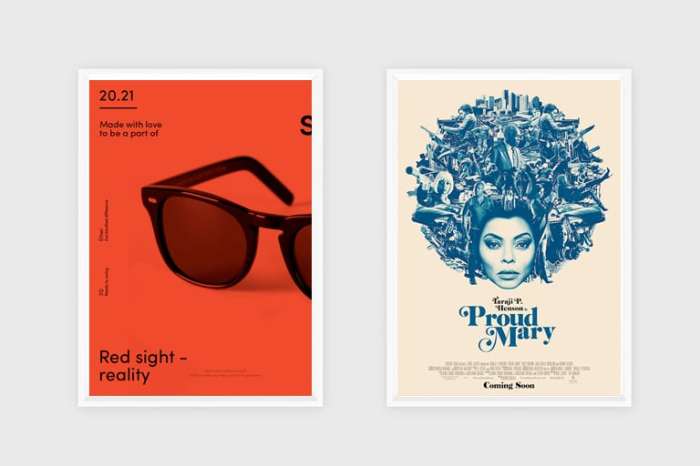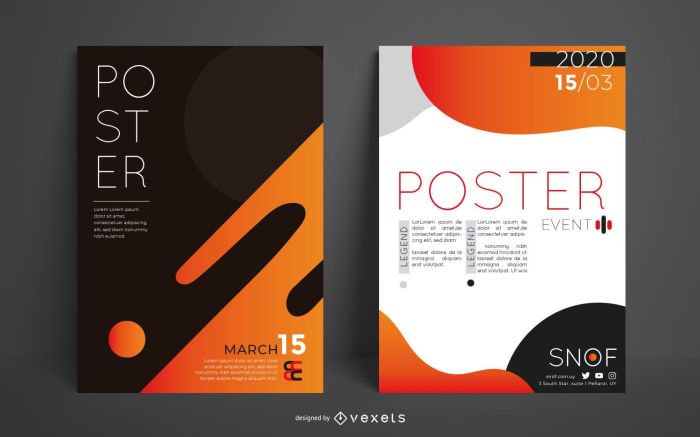Crafting Captivating Poster Designs: A Comprehensive Guide
Poster design is a powerful medium for conveying messages effectively and creatively. From vibrant colors to captivating typography, each element plays a crucial role in capturing the audience's attention and delivering a compelling message. In this guide, we will explore the key aspects of poster design that can help you create visually stunning and impactful posters.
Importance of Poster Design
Poster design plays a crucial role in effectively conveying messages to the audience. A well-designed poster can attract attention, communicate information clearly, and leave a lasting impact on viewers.
Role of Color in Poster Design
Color is a powerful tool in poster design as it can evoke emotions, create visual interest, and enhance the overall message. For example, a poster promoting a beach vacation may use bright and vibrant colors to convey a sense of fun and relaxation.
Typography in Poster Design
The choice of typography in a poster can greatly impact how the message is perceived. Bold and easy-to-read fonts are often used for important information, while decorative fonts may be used to add personality or style to the design. For instance, a music festival poster may use edgy typography to reflect the genre of music being showcased.
Layout and Composition in Poster Design
The layout and composition of a poster determine how information is organized and presented to the audience. A well-balanced layout can guide the viewer's eye through the content in a logical manner. For example, a poster promoting a new product may strategically place the product image and key features to capture attention and encourage further reading.
Elements of a Compelling Poster
Creating a compelling poster involves incorporating key elements that will grab the attention of the audience and effectively convey the intended message. These elements work together to make the poster visually appealing and engaging.
Choosing the Right Color Scheme
When designing a poster, selecting the appropriate color scheme is crucial as colors can evoke emotions and convey different messages. The right colors can help to attract attention, create a mood, and highlight important information. It is essential to consider the target audience and the message being communicated when choosing colors for a poster.
Contrasting colors can make important details stand out, while complementary colors can create a harmonious and visually pleasing design.
Role of Imagery and Graphics
Incorporating high-quality imagery and graphics can significantly enhance the visual appeal of a poster. Images can help to communicate complex ideas quickly and effectively, making the information more engaging and memorable for viewers. Graphics such as charts, illustrations, and icons can also be used to visually represent data or concepts, making the content easier to understand.
When selecting images and graphics for a poster, it is important to ensure that they are relevant to the message and of high quality to maintain the overall professional look of the design.
Typography in Poster Design

Typography plays a crucial role in poster design as it helps convey the message effectively and capture the attention of the audience. The choice of fonts, sizes, and styles can impact how the information is perceived and understood. Here, we will explore the significance of typography in poster design, different font styles and sizes that work well for various types of posters, and tips on how to effectively use typography to make key information stand out on a poster.
Significance of Typography
Typography is more than just selecting a font; it is about creating a visual hierarchy that guides the viewer through the content. The right choice of typography can evoke emotions, emphasize important details, and improve overall readability. It helps in setting the tone of the poster and conveying the intended message clearly.
Different Font Styles and Sizes
- For formal or professional posters, serif fonts like Times New Roman or Georgia are suitable for conveying a sense of elegance and credibility.
- For modern and sleek posters, sans-serif fonts like Helvetica or Arial work well to give a clean and contemporary look.
- Display fonts can be used for titles or headings to add personality and uniqueness to the design.
- When it comes to font sizes, make sure that the most important information is the largest and most prominent, while secondary details are smaller but still easily readable.
Tips for Effective Typography
- Avoid using too many different fonts in one poster; stick to a maximum of two to three fonts for a cohesive look.
- Contrast is key - use a combination of font styles, sizes, and weights to create visual interest and hierarchy.
- Pay attention to spacing and alignment to ensure that the text is easy to read and flows well within the design.
- Consider the background color and texture when choosing font colors to ensure readability and contrast.
- Experiment with typography to see what works best for your poster design and always prioritize legibility over creativity.
Design Tools and Software for Poster Creation

When it comes to creating visually appealing and professional posters, having the right design tools and software is essential. These tools offer a wide range of features and functionalities that can help you bring your poster ideas to life. Let's explore some popular design tools and software used for poster creation, compare their features, and provide a step-by-step guide on how to create a poster using a specific design tool or software.
Popular Design Tools and Software
- Adobe Photoshop: Adobe Photoshop is a versatile design software that is widely used for creating posters. It offers a variety of tools for image editing, graphic design, and typography, allowing you to customize every aspect of your poster design.
- Canva: Canva is a user-friendly online design tool that is perfect for beginners and professionals alike. It provides a wide range of templates, graphics, and fonts to help you design stunning posters quickly and easily.
- Adobe Illustrator: Adobe Illustrator is another powerful design software that is ideal for creating vector-based graphics. It offers advanced drawing tools, typography features, and color controls, making it perfect for designing intricate and detailed posters.
- PosterMyWall: PosterMyWall is an online platform that offers customizable poster templates and design tools. It allows you to easily create professional-looking posters for various purposes, including events, promotions, and announcements.
Step-by-Step Guide for Creating a Poster using Canva
- Sign up for a Canva account or log in if you already have one.
- Select the "Poster" design type from the Canva homepage to start a new project.
- Choose a template that suits your poster design needs or start from scratch by selecting a blank canvas.
- Customize your poster by adding text, images, shapes, and other elements using Canva's drag-and-drop editor.
- Experiment with different fonts, colors, and layouts to create a visually appealing design that conveys your message effectively.
- Preview your poster to make sure everything looks good, then download it in your preferred format (PNG, JPEG, PDF).
Ultimate Conclusion
In conclusion, mastering the art of poster design involves a careful balance of creativity and strategy. By understanding the importance of design elements and choosing the right tools, you can create posters that not only inform but also inspire and engage your audience.
Start experimenting with different techniques and unleash your creativity to craft posters that leave a lasting impression.
Question & Answer Hub
What role does color play in poster design?
Color is essential in setting the mood and attracting attention. It can evoke emotions and create visual interest in a poster design.
How can typography enhance a poster design?
Typography helps in conveying the tone and message of the poster. Choosing the right font styles and sizes can make the information more prominent and visually appealing.
Which design tools are commonly used for creating posters?
Popular design tools for poster creation include Adobe Illustrator, Canva, and Photoshop. Each has its unique features for creating visually stunning posters.




